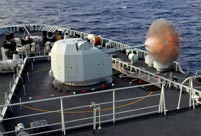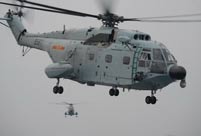On the morning of Sept. 8, two H-6 bombers of the Chinese People's Liberation Army (PLA) Navy made training flights across the sea area between the main Japanese islands of Okinawa and Miyako-Jima, and on to the West Pacific. Fighters of Japan Air Self Defense Force were scrambled urgently in response.
In an interview with People's Daily Online, General Yin Zhuo acknowledged that there had been flights of PLA bombers across the island chain. The combat range of these long-range bombers is over 2,000 km, and the purpose of training beyond the island chain is to assess tactical performance. Only by flying across the first island chain and on to the outer ocean can the limits of the maximum radius of operations be tested.
The Ministry of National Defense of China commented that this was part of routine training, and it would continue in the future
The Ministry of National Defense responded to reports of the Chinese bomber flights in the Japanese media by stating that military flight training in the West Pacific is a routine task in line with the annual schedule, is not aimed at any other country or any specific target, and is in accordance with the relevant international laws and practices. It also stated that the PLA would continue such routine operations in accordance with its future training schedules.
PLA bomber flights across the first island chain will help the development of tactics
Yin Zhuo explained in the interview that the bombers were always within the training range of the Chinese PLA Navy. He also pointed out that the combat range of long-range bombers is over 2,000 km, and that limiting training to the area within the island chain would hamper assessment of their tactical performance. Only by flying across the first island chain to the outer ocean can the limits of maximum flight radius and long-range operations be tested. It can therefore be anticipated that long-range training flights and voyages of both PLA aircraft and vessels will be standard practice. Japanese fighter responses will not affect the training activities of PLA aircraft.
According to Yin Zhuo, their enhanced response is a unilateral matter for Japan. An "air defense identification zone" is simply a range of alert that is determined unilaterally by one country in terms of international law. It does not have to be recognized or accorded any significance by other countries, nor does it have any legal status.
The range of the air defense identification zone defined by Japan is very broad, extending as far as the coast of Jiangsu Province in China. Whenever PLA aircraft take off within this area, they are considered to have entered Japan's air defense identification zone, which is extremely unreasonable.
Yin Zhuo pointed out that PLA aircraft should be able to transit international air space freely. He concluded that the PLA training schedule would continue as planned, and would not be influenced either by public opinion in Japan, or by responses from Japanese fighters.
 Highlights of opening ceremony of Sochi 2014 Winter Olympic Games
Highlights of opening ceremony of Sochi 2014 Winter Olympic Games Highlights of Chinese New Year celebrations around the world
Highlights of Chinese New Year celebrations around the world  Chinese ship formation conducts live fire training in West Pacific
Chinese ship formation conducts live fire training in West Pacific Sanya bans skinny dipping in public beach
Sanya bans skinny dipping in public beach Top 20 most beautiful Chinese stars
Top 20 most beautiful Chinese stars  PLA navy conducts landing drills in South China Sea
PLA navy conducts landing drills in South China Sea  Snowscape in Chinese New Year
Snowscape in Chinese New Year Top 10 timeless female Chinese stars
Top 10 timeless female Chinese stars Top 10 Chinese films in 2013
Top 10 Chinese films in 2013 New Year greetings from Chinese nationals in Africa
New Year greetings from Chinese nationals in Africa Miss Chinese Int'l Pageant 2014 held in Hong Kong
Miss Chinese Int'l Pageant 2014 held in Hong Kong Severe coldness freezes large parts of China
Severe coldness freezes large parts of China  Beautiful moments of Sochi
Beautiful moments of Sochi  It's not just performing this year
It's not just performing this year Selfies of "Little colorful flag" girl unveiled
Selfies of "Little colorful flag" girl unveiled Day|Week|Month